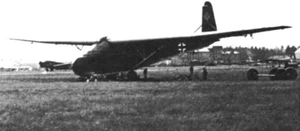
Me 321 Glider on the ground[1]
The Messerschmitt Ms 321 was a large transport glider originally developed for Operation Sealion, the planed German invasion of Great Britain.
Design[]
Chosen ahead of the competing Junkers Ju 322, which was abandoned, the Me 321 prototype was a shoulder winged aircraft with a internal cargo space measuring 36 ft 1 in (11.00 m) in length, 10 ft 4 in (3.15 m) in width and 10 ft 10 in (3.30 m) in height. This had a capacity for 200 troops or up to 44,092 lb (20,000 kg) of cargo, almost double the empty weight. Flight tests were conducted using a jettisonable take off dolly, with sprung skids used for landing.[2]
Testing[]
First flown on February 25 1941, with a Junkers Ju 90 as a tug, the 321 proved to have satisfactory handling characteristics, but suffered a number of accidents during the take off phase, indicating the need for a more efficient tug. This led to the development of the He 111Z. in addition to the tug, the Me 321 could use up to eight rocket packs, each providing 1,102 lb (4.90 kN) of thrust for 30 seconds, to assist the take off, especially when carrying a heavy load.[2]
Production[]
Following construction of 100 examples of the initial Me 321A-1, Messerschmitt built another 100 examples under a contract for the improved Me 321B-1 version, which had a wider flight deck to accommodate a co-pilot. However, continuing take off problems led to the development of a powered version, the Messerschmitt Me 323.[2]
References[]
- ↑ WW2 Vehicles
- ↑ 2.0 2.1 2.2 World Aircraft Information Files Aviation Partwork. Midsummer Books Ltd. File 901 Sheet 12 (A-Z of Aircraft: Messerschmitt Me 210 and Me 410 Hornisse (continued) to Messerschmitt Me 321 and Me 323 Gigant)